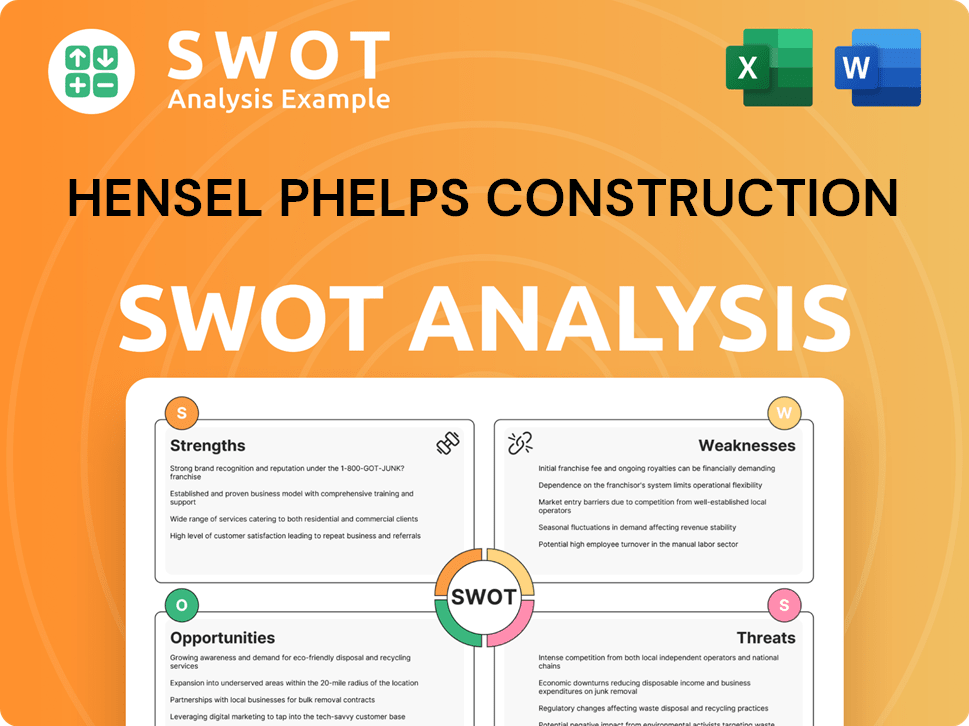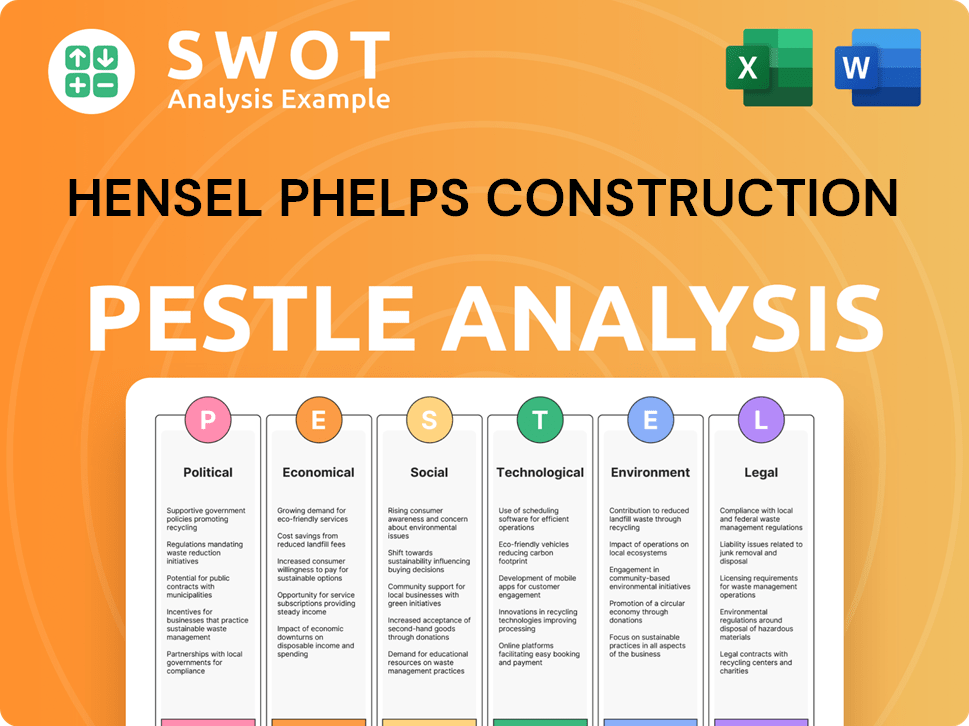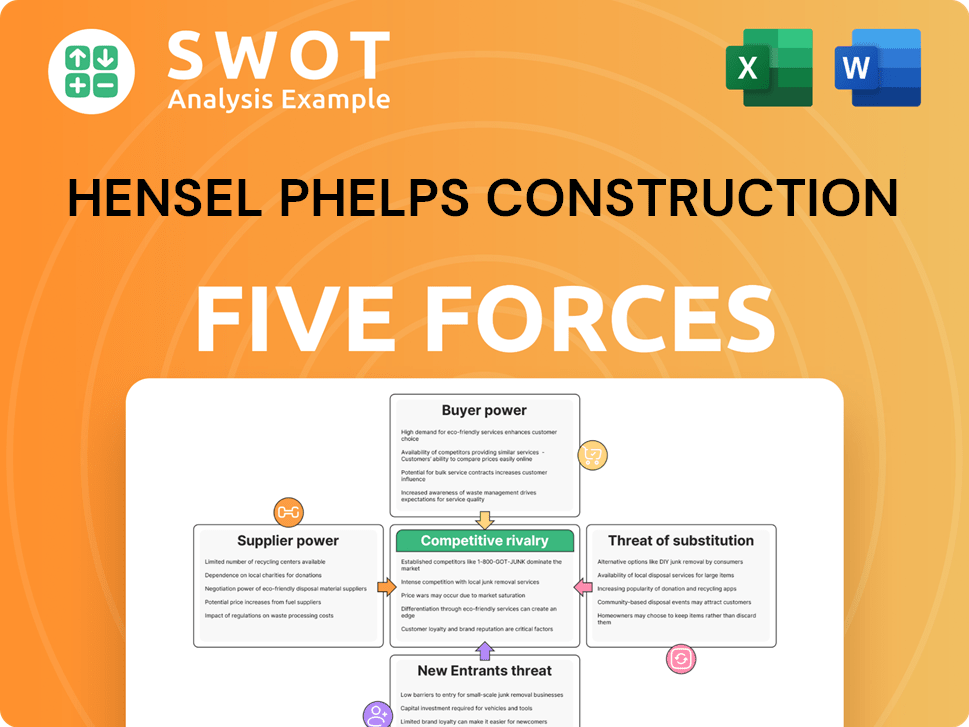Hensel Phelps Construction Bundle
Who Really Owns Hensel Phelps Construction?
Uncover the ownership secrets of one of America's construction giants. Understanding the Hensel Phelps Construction SWOT Analysis and its ownership structure is vital for anyone looking to understand its strategic moves and industry influence. From its humble beginnings to its current status, the story of Hensel Phelps is a fascinating study in business evolution.

Founded in 1937, Hensel Phelps Construction Company has a rich history, evolving from a residential builder to a major player in the construction industry. This exploration into Hensel Phelps ownership will reveal the key stakeholders and how their decisions have shaped the company's impressive growth, including its transition to employee ownership. Discover the factors influencing the company's $7.1 billion revenue and its impact on the construction market.
Who Founded Hensel Phelps Construction?
The story of Hensel Phelps Construction began in June 1937 in Greeley, Colorado, when Abel Hensel Phelps established the company. Initially, the focus was on residential construction, including home building and remodeling projects. This marked the start of what would become a significant player in the construction industry.
A key moment in the company's evolution occurred in 1955 when Joseph Phelps, Abel's son, joined the firm. Following Abel's retirement, Joseph took charge, incorporating the company on June 3, 1957. He then served as president and general manager until 1975, steering the company through its formative years.
The transition to employee ownership was a defining chapter in the Hensel Phelps story. Joseph Phelps, along with Robert Tointon, spearheaded an employee ownership program over a period of 25 years. This culminated in 1989, when ownership was transferred to the employees.
Hensel Phelps Construction was founded in June 1937 by Abel Hensel Phelps in Greeley, Colorado.
Joseph Phelps, Abel's son, joined the company in 1955 and later incorporated it in 1957.
The company transitioned to employee ownership in 1989, with ownership distributed among twenty-eight employee stockholders.
The employee buyout involved the reorganization of Phelps Inc., under Jerry Morgensen and other managers.
This transition reflected a commitment to fostering dedication and shared success among the workforce.
No individual held more than a 10 percent stake in the company after the employee buyout.
The move to employee ownership, as detailed in Brief History of Hensel Phelps Construction, was a strategic decision designed to cultivate a dedicated workforce and align the success of the company with the interests of its employees. This ownership structure has remained a key aspect of Hensel Phelps' identity, fostering a culture of shared responsibility and commitment to quality. The company's history shows a focus on long-term sustainability and employee engagement, which continues to influence its operations today.
Hensel Phelps Construction SWOT Analysis
- Complete SWOT Breakdown
- Fully Customizable
- Editable in Excel & Word
- Professional Formatting
- Investor-Ready Format

How Has Hensel Phelps Construction’s Ownership Changed Over Time?
The ownership structure of Hensel Phelps Construction has seen a significant shift over time. Initially under private family ownership, the company transitioned to an employee-owned model. This pivotal change occurred in 1989 when Joseph Phelps and Robert Tointon transferred ownership to the employees, establishing Hensel Phelps as an employee-owned company, a status it maintains to this day. This transition marked a significant step in the company's history, altering its governance and operational dynamics.
As an employee-owned entity, Hensel Phelps's employees collectively share in the company's success. This structure, facilitated through an Employee Stock Ownership Plan (ESOP), means that employees themselves are the owners, rather than external shareholders or a single private entity. This model has fostered a strong sense of ownership and commitment among the workforce. The average employee tenure at Hensel Phelps is reported to be around 13 years, which is a testament to the employee-owned model, which allows knowledge and expertise to be passed down through generations. This long-term approach has contributed to the company's stability and reputation within the construction industry.
| Year | Ownership Change | Impact |
|---|---|---|
| 1989 | Ownership transferred to employees | Established Hensel Phelps as an employee-owned company. |
| Ongoing | Employee Stock Ownership Plan (ESOP) | Ensures employees are the owners, fostering commitment and long-term focus. |
| Present | Employee-owned structure | Contributes to the company's financial strength and long-term success. |
The financial performance of Hensel Phelps reflects the success of its ownership model. The company's revenue reached approximately $6.94 billion in 2023 and is estimated to be around $7.1 billion in 2024. This financial strength is a direct result of the employee-owned structure. The company's history with its ESOP spans over four decades, highlighting the long-term viability and benefits of this ownership model. For more insights, you can explore the Marketing Strategy of Hensel Phelps Construction.
Hensel Phelps Construction is an employee-owned company, a model that has been in place since 1989.
- Employees own the company through an Employee Stock Ownership Plan (ESOP).
- The employee-owned structure has contributed to the company's financial success.
- Revenue reached approximately $6.94 billion in 2023 and $7.1 billion in 2024.
- The employee-owned model has been in place for over 40 years.
Hensel Phelps Construction PESTLE Analysis
- Covers All 6 PESTLE Categories
- No Research Needed – Save Hours of Work
- Built by Experts, Trusted by Consultants
- Instant Download, Ready to Use
- 100% Editable, Fully Customizable

Who Sits on Hensel Phelps Construction’s Board?
The leadership of Hensel Phelps Construction, a prominent construction company, is structured around a Board of Directors and an executive team. As an employee-owned entity, the composition of the board and the voting structure are aligned with internal leadership and the interests of its employee-owners. This structure differs from publicly-traded companies, where external shareholders have a direct influence.
Currently, Michael J. Choutka serves as Chairman and CEO, a role he has held since January 1, 2024. Brad Jeanneret is the President and Chief Operating Officer, also appointed on January 1, 2024. The executive leadership team also includes Allan J. Bliesmer, Jennifer K. Scholz (Vice President and Chief Financial Officer), Robert P. Majerus (Vice President and General Counsel), Laird B. Heikens, Joel B. Douglass, and Derek H. Hoffine, who was promoted to Executive Vice President in January 2025. Tom Diersbock was also promoted to Executive Vice President effective January 1, 2024.
| Executive Role | Name | Start Date |
|---|---|---|
| Chairman and CEO | Michael J. Choutka | January 1, 2024 |
| President and COO | Brad Jeanneret | January 1, 2024 |
| Executive Vice President | Derek H. Hoffine | January 2025 |
| Executive Vice President | Tom Diersbock | January 1, 2024 |
The voting structure within Hensel Phelps, as an employee-owned company, ensures that employees, as stockholders, participate in the company's success. While specific details about individual voting power are not publicly disclosed, the governance emphasizes employee engagement and internal leadership. Recent appointments, such as Matt McCaulley as Chief Administrative Officer and Jerry Shupe as Chief Health and Safety Officer, reflect the board's focus on supporting growth and operational alignment. These changes demonstrate the company's commitment to strengthening its internal capabilities and strategic vision. Understanding the Hensel Phelps Construction Company leadership is key to grasping its operational approach.
Hensel Phelps is an employee-owned construction company, which influences its governance and operational strategies. The leadership structure includes a Board of Directors and an executive team, with recent appointments reflecting a focus on internal growth and operational efficiency.
- Employee ownership fosters a collaborative work environment.
- Leadership changes in 2024 and 2025 highlight strategic priorities.
- The company's structure supports long-term sustainability.
- Focus on employee engagement and internal capabilities is evident.
Hensel Phelps Construction Business Model Canvas
- Complete 9-Block Business Model Canvas
- Effortlessly Communicate Your Business Strategy
- Investor-Ready BMC Format
- 100% Editable and Customizable
- Clear and Structured Layout

What Recent Changes Have Shaped Hensel Phelps Construction’s Ownership Landscape?
Over the past few years, the ownership structure of Hensel Phelps has remained consistent, with the company continuing as a leading employee-owned general contractor. This model, where employees hold ownership, has been a key factor in its operational philosophy and long-term stability. The construction industry sees significant success with Employee Stock Ownership Plans (ESOPs), which often lead to higher employee loyalty and a more stable workforce.
The financial performance of Hensel Phelps demonstrates its strong market position. In 2023, the company reported a revenue of $6.94 billion, reflecting a substantial two-year growth of 31%. Projections for 2024 estimate revenue at approximately $7.1 billion. The company has also secured significant contracts, such as the $274.7 million border station expansion in Arizona, awarded in October 2024, and the $173.6 million contract for the final phase of the Calexico West Land Port of Entry modernization in California, with construction slated from summer 2025 to winter 2028. Additionally, Hensel Phelps was awarded the $31.5 million Advanced Munitions Training Complex (AMTC) Phase III project at Eglin Air Force Base, FL, with an estimated completion date of January 2026.
| Metric | Value | Year |
|---|---|---|
| Revenue | $6.94 billion | 2023 |
| Projected Revenue | $7.1 billion | 2024 |
| Two-Year Revenue Growth | 31% | 2023-2024 |
Leadership changes within Hensel Phelps have been notable, particularly in recent years. Effective January 1, 2024, Brad Jeanneret became President and Chief Operating Officer, while Mike Choutka remained Chairman and CEO. Several promotions were also announced, including Tom Diersbock to Executive Vice President, and the creation of new executive roles, such as Chief Administrative Officer (Matt McCaulley) and Chief Health and Safety Officer (Jerry Shupe). Further changes were announced for January 1, 2025, with Derek Hoffine promoted to Executive Vice President and Charlie Robben appointed as Regional Vice President for the Rocky Mountain Region. These internal promotions reflect the company's commitment to developing leaders from within. For more insights into the company's strategic growth, you can read about the Growth Strategy of Hensel Phelps Construction.
Hensel Phelps remains privately held and employee-owned, fostering long-term stability and employee loyalty.
The company reported $6.94 billion in revenue in 2023, with approximately $7.1 billion projected for 2024.
Recent leadership appointments include Brad Jeanneret as President and COO, effective January 1, 2024.
Hensel Phelps was recognized as the safest construction company in the nation in 2024 by the AGC.
Hensel Phelps Construction Porter's Five Forces Analysis
- Covers All 5 Competitive Forces in Detail
- Structured for Consultants, Students, and Founders
- 100% Editable in Microsoft Word & Excel
- Instant Digital Download – Use Immediately
- Compatible with Mac & PC – Fully Unlocked

Related Blogs
- What are Mission Vision & Core Values of Hensel Phelps Construction Company?
- What is Competitive Landscape of Hensel Phelps Construction Company?
- What is Growth Strategy and Future Prospects of Hensel Phelps Construction Company?
- How Does Hensel Phelps Construction Company Work?
- What is Sales and Marketing Strategy of Hensel Phelps Construction Company?
- What is Brief History of Hensel Phelps Construction Company?
- What is Customer Demographics and Target Market of Hensel Phelps Construction Company?
Disclaimer
All information, articles, and product details provided on this website are for general informational and educational purposes only. We do not claim any ownership over, nor do we intend to infringe upon, any trademarks, copyrights, logos, brand names, or other intellectual property mentioned or depicted on this site. Such intellectual property remains the property of its respective owners, and any references here are made solely for identification or informational purposes, without implying any affiliation, endorsement, or partnership.
We make no representations or warranties, express or implied, regarding the accuracy, completeness, or suitability of any content or products presented. Nothing on this website should be construed as legal, tax, investment, financial, medical, or other professional advice. In addition, no part of this site—including articles or product references—constitutes a solicitation, recommendation, endorsement, advertisement, or offer to buy or sell any securities, franchises, or other financial instruments, particularly in jurisdictions where such activity would be unlawful.
All content is of a general nature and may not address the specific circumstances of any individual or entity. It is not a substitute for professional advice or services. Any actions you take based on the information provided here are strictly at your own risk. You accept full responsibility for any decisions or outcomes arising from your use of this website and agree to release us from any liability in connection with your use of, or reliance upon, the content or products found herein.